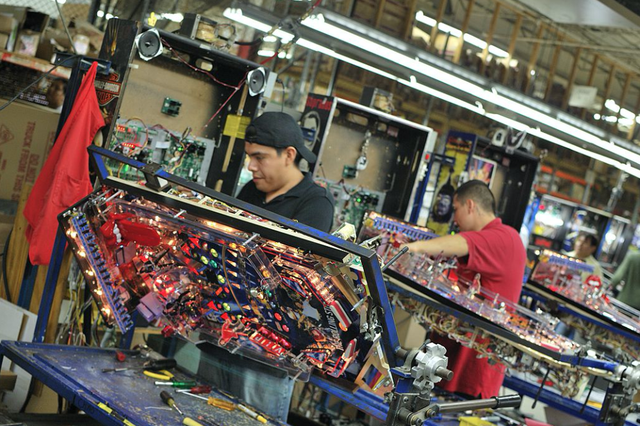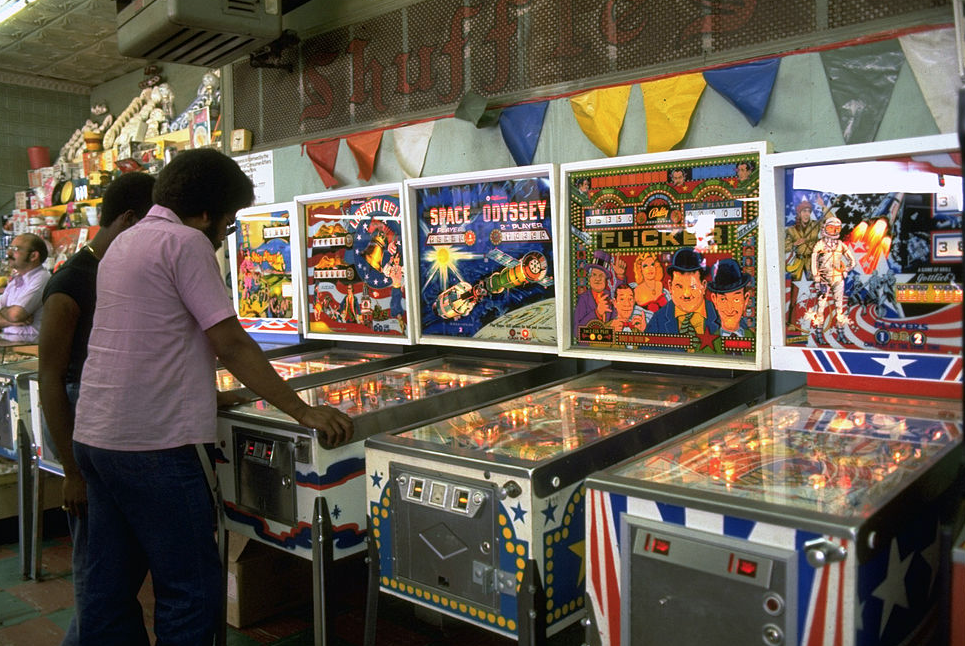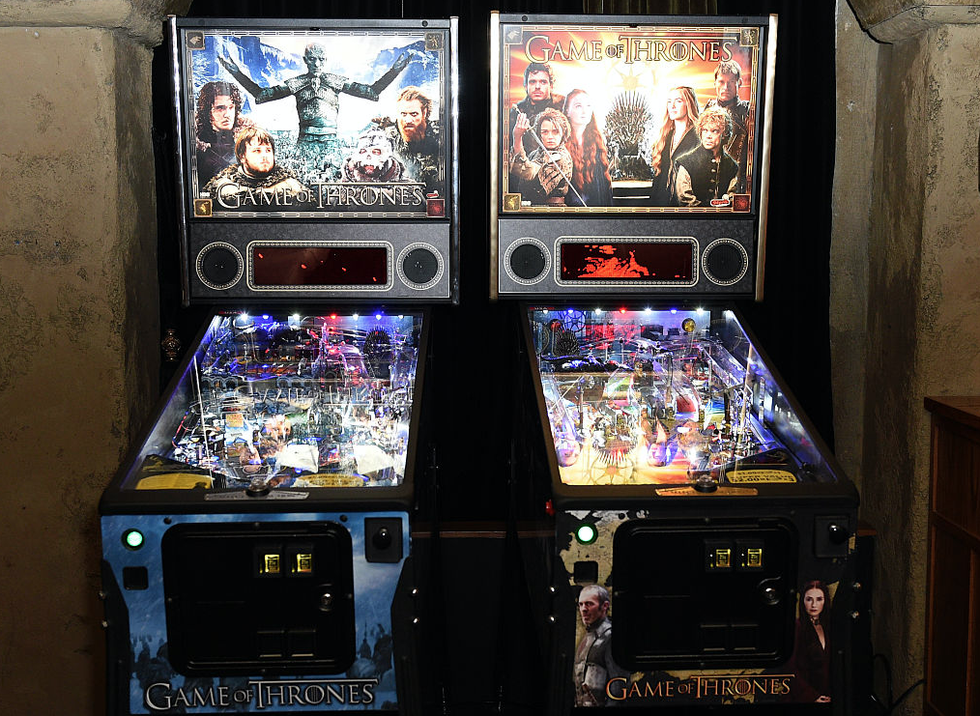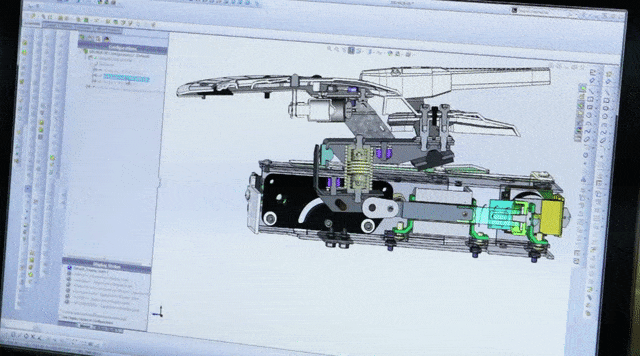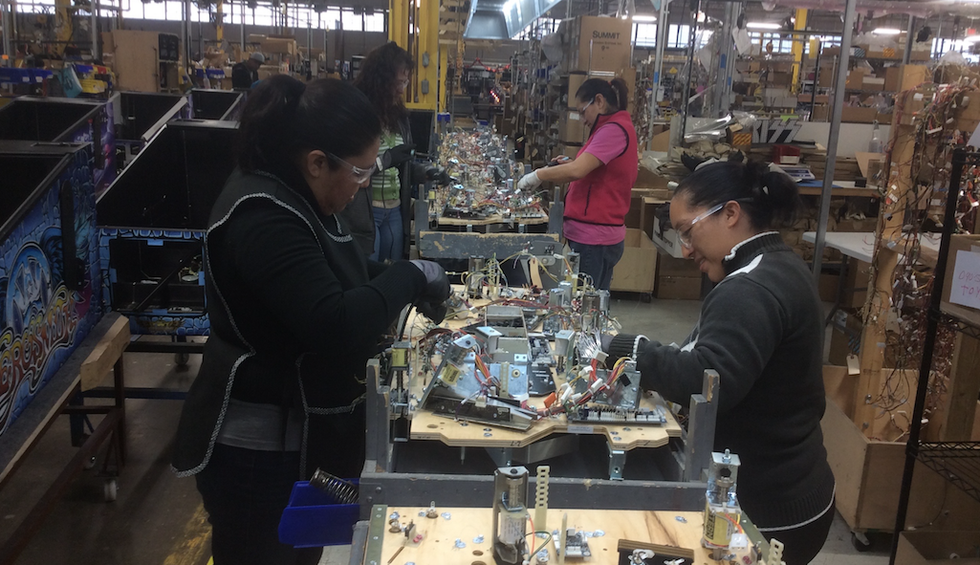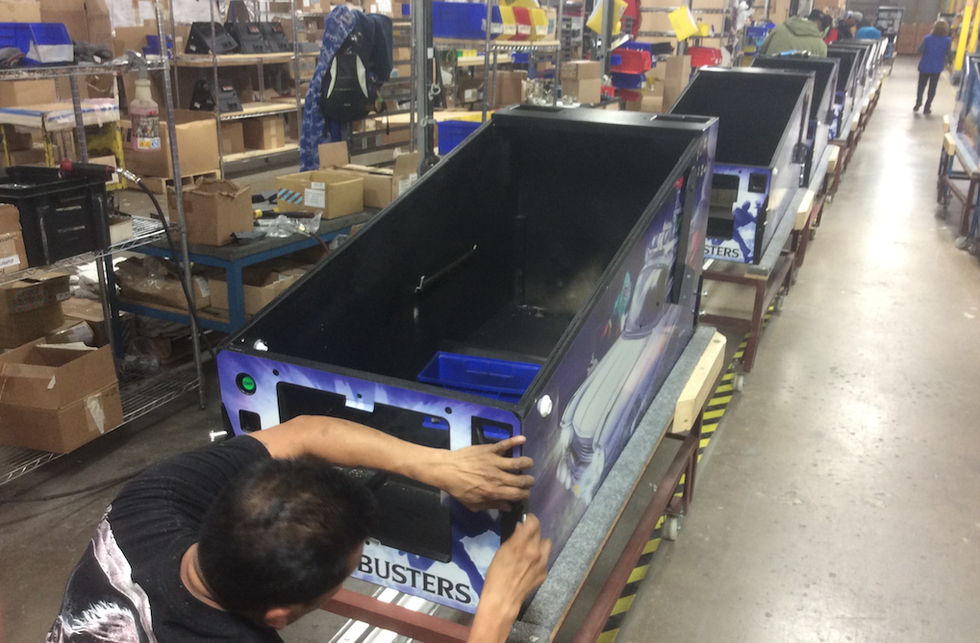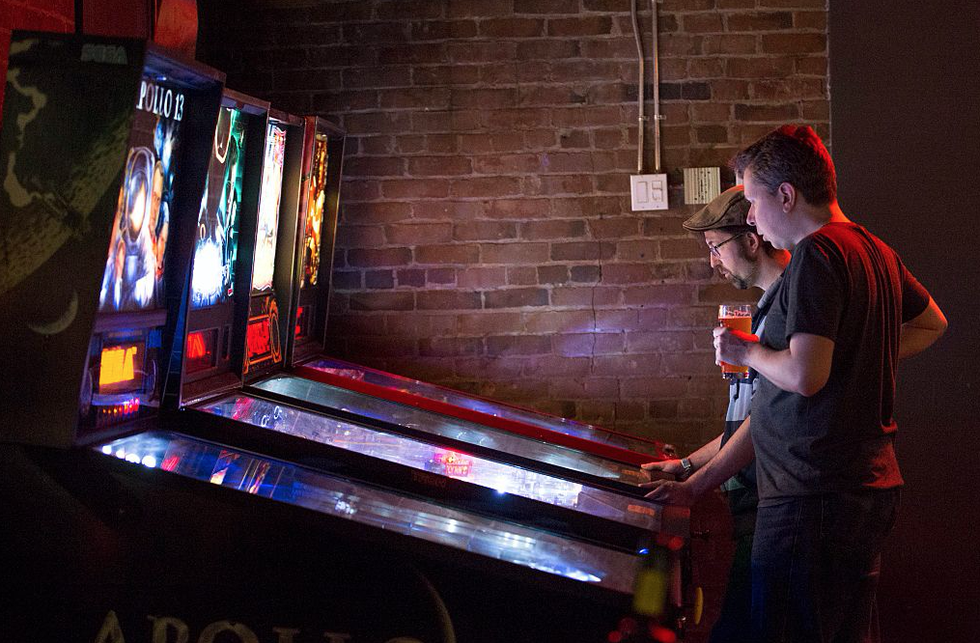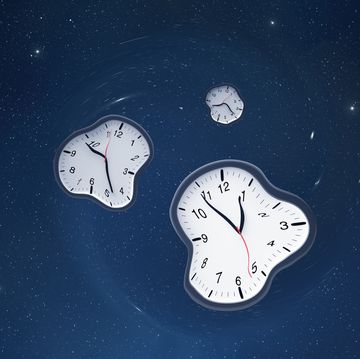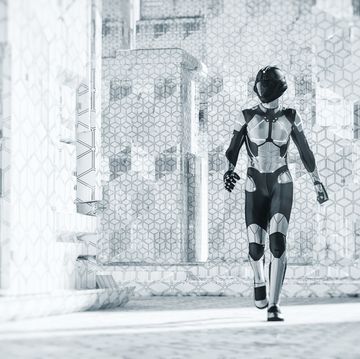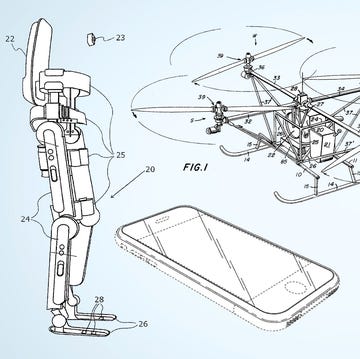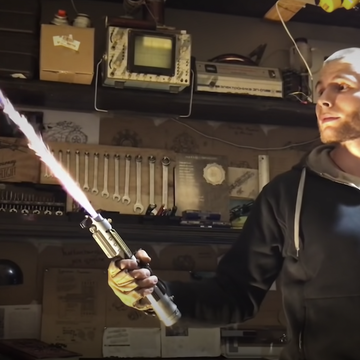In the late 1980s and early '90s, if you lost a quarter to a mercilessly tough pinball machine, you likely lost it to a game designed by one of the four big players: Stern, Williams, Bally, or Gottlieb, all pinball makers headquartered in Chicago. But that once shimmering golden age of pinball is now gone, and now only one remains.
As video game consoles entered millions of homes in the early 90s, arcades shuttered and faltering sales forced Williams to abandoned pinball. Gottlieb shut down shortly thereafter, and Bally, bought by Hilton Hotels, disappeared from the business entirely.
Today, there are boutique pinball manufacturers like Jersey Jack Pinball that keep the industry's blood pumping with a specialized release every few years. But in terms of major pinball machine makers, only Stern Pinball is still in the game. We got a look inside their Chicago factory to see how a 21st century pinball machine comes together.
The Fall of Pinball
While Chicago would become the home of big pinball, the city actually tried to kill the game first. Pinball's first brush with near-death came in the mid 20th century, when Chicago, along with major metros like New York City and Los Angeles, banned the game. Anti-gambling proponents claimed that the game's randomness qualified it as a game of chance. Two decades later those bans were finally lifted nationwide. In 1977, Stern Pinball started up.
Stern's first major license was a game based on the rockstar Ted Nugent in 1978. Over the decades, the company would be sold back and forth by the likes of Data East to Sega, mirroring the ebb and flow of a chaotic industry. Eventually control of the company returned to founder and president Gary Stern in 1994—right around the time the industry was sinking. Now in its 40th year, Stern Pinball remains a family business.
Located roughly 25 miles northwest of Chicago in the village of Elk Grove, Illinois, Stern's factory is as uniformly nondescript as the 3,600 businesses surrounding it in what is the country's biggest consolidated business park. The streets are quiet save for the passing hum of airliners overhead, taking off from nearby O'Hare International Airport. Once you're through the front doors, though, Stern Pinball is 10,000 square feet of flaring lights, sparking soldering irons, molded rubber creatures waiting to be affixed to playfields, and thousands of miles of cable waiting to wire the next great pinball game.
And a great pinball game requires a great amount of craftsmanship, involving more than 300 employees to design, build, and ship the next great pinball machine to your favorite neighborhood bar.
Step 1: Finding a License
Although pinball has a passionate fan base, Stern releases just three machines a year, leaving a very slim margin for error. Gone are the days of an untested action pic like 1993's Last Action Hero automatically getting a pinball tie-in. Although movie flops like the Johnny Mnemonic or The Shadow can turn into incredible games (and collector pieces), even popular movies and artists aren't guaranteed pinball immortality if it seems like they might be a flash in the pan.
The highest-selling pinball machine, Bally's Addams Family, sold 20,000 units in 1992. Today, Stern's biggest sellers like Game of Thrones and Ghostbusters move only half as many games, with others selling considerably fewer. Creating just one single game requires designers, mechanical engineers, electrical engineers, programmers, artists, and costs upwards of $1 million, with a production window as long as 15 months.
In other words, you need to make a game people are going to buy.
"It's like a movie studio," says Jody Dankberg, Stern's director of marketing and licensing. "Everyone is coming together to make sure it's this cohesive, entertainment experience that all hangs together."
Step 2: Designing the Game
Once Stern books a license, the lead designer and programmer dream up every aspect of the game inside a single office. First, the layout of the playing field and geometry of the shots are drafted on computer using an in-house emulator.
"Initial meetings are really blue sky thinking, pure creative brainstorming," says George Gomez, Stern's vice president of game development. "We'll think of what would be cool, but then we have to deal with how it affects the gameplay."
A successful mockup could mean a lot of things depending on the type of game you're trying to make. Do the ramps and angle of the shots flow into each other organically? Is it a game about simply scoring points, or is it about a more complex story? The Addams Family's tremendous success was partially credited to having the film's actors record dialogue just for the game and building in an entirely new story.
But at some point, the game needs to move from the virtual to the physical.
"We have to actually see how it works, so we do a mockup and we adjust the mechanisms over and over again until the shots are nice and smooth," Gomez says. "Games are about feedback, so everything needs to have a cause and effect. We need to make sure it feels like you're progressing, that you're making the field react in some way, and we need to make sure there aren't any places the ball is just going to land and get stuck."
Once the designers are sure, the playfield is fabricated and silk screened with graphics onsite. Because a playfield will be responsible for anchoring so many various parts, they need to be made from durable wood. Stern uses a tight grain Finland plywood, something like a Russian birch, before a maple veneer is added to the top and bottom for extra hardness.
Step 3: Sub-Assembly
With nearly 3,500 parts, two dozen cables, and half-a-mile of wiring per game, building a working playfield is a time-consuming process that can take as long as two weeks to a month per game, depending on the build's specifications.
Playfields are given extra holes specific to their game design using specialized drill plates before heading to two different lines for assembly. In the first line, wiring is attached to the playfield. Because the games are subjected to so much vibration, they need to be hand-soldered and bit parts like switches and lights must be tested.
In the second line, the playfields are married to the metal frame of the cabinets where connections will be tested all over again. Then cabinets arrive at Stern as blank slates ready to be printed with a game's specific artwork.
Step 4: Assembly and Testing
There are worse ways to make a living than testing pinball games for hours and hours. Stern employees subject games to ball after ball of stress, looking for failures in the build like a light that fails to fire, a bum flipper, or a bug in the software. Because of every game's specific ecosystem of moving mechanical parts, this process needs to be thorough.
Assuming the game passes muster, it's boxed up for shipping to one of Stern's customers—whether in the U.S. or around the world. If employees are still itching to shoot a ball or two on their off-time, Stern has an arcade with every game the company has ever made—from old failures like Terminator 3: Rise of the Machines to the new ultra popular Metallica.
The Rebirth of Pinball
Companies like Stern keep a uniquely American form of manufacturing alive, but also a form of gaming that would likely disappear if they didn't keep the flame burning. Thanks to the growing trend of successful businesses like Barcade (pretty much exactly what it sounds like), and a growing number of Baby Boomer collectors, sales have started to move up again for the first time since the '90s crash.
The future is much more than just plywood and flipper switches. Just look at a game like Batman '66, based on the perpetually popular Adam West TV show, to see how far the mechanics have come. The playfield is jam packed with tech—miniature televisions, turntables filled with rotating targets, video displays, vacuum formed plastics—leaving just enough room for the ball.
"If there's one thing I want to do it's get it out of people's heads that pinball machines are the same games they were 50 years ago," Gomez says. "High tech electronics, laser cutting parts—just about any manufacturing discipline and every cross section of technology and electromechanical devices you can think of—all of that is going into pinball today."
Stern is even going beyond the traditional playfield and working with VR maker Oculus and video game developer FarSight Studios to create a virtual pinball arcade, preserving a unique game experience for a future generation of gamers.
But even as Stern pushes the boundaries of what pinball can be, the company's team of engineers, designers, and artists will continue doing what Stern does best—making damn good pinball machines.

